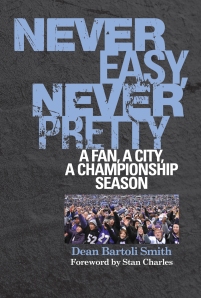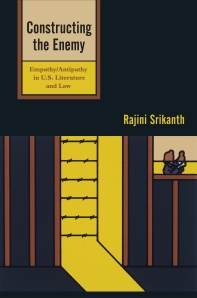In this Q&A, Temple University Press author Dean Bartoli Smith talks about his football fandom, going to Super Bowl XLVII, and his new book, Never Easy, Never Pretty: A Fan, A City, A Championship Season.
Q: In the first chapter of Never Easy, Never Pretty you write about your love affair with football, and how it began in 1970, when you were 7. Your father took you to a Colts practice game. What was it that sparked your interest in the game/team?
DBS: I was immersed in Baltimore Colts football as an infant rolling around on the carpet as the game unfolded on a black-and-white television in the late 1960s. I learned about the team in books like Great Moments in the NFL as soon as I could read. My fandom was sealed when I received a Colts helmet as a gift. I wore that blue horseshoe against a pure white background everywhere. My relatives told stories around the dinner table about the football exploits of Johnny Unitas, Raymond Berry, Mike Curtis, and Bubba Smith. I couldn’t believe I was going to meet them in person at a practice game. Carrying Unitas’ shoulder pads after practice changed my life.
Q: The book has an interesting structure—while it is a game-by-game analysis of the Raven’s 2012 Championship Season, it is also a history of the team, and a memoir of sorts. How did you conceive of the narrative?
DBS: The season dictated the narrative structure; the games themselves provided a crude outline. The writing was very much like a playing in a football game. I needed to drive the narrative down the field, find the open holes and pass to the open receivers. In the first three games, the team experienced the loss of Art Modell and Torrey Smith’s brother and played one-point games against the Eagles and Patriots—nothing was going to be easy. The Ravens set the tone early on that overcoming loss was going to be a major theme. Then you have three “trench warfare” wins (Browns, Chiefs, and Cowboys) that were brutal slugfests. Ray Lewis and Lardarius Webb go down. In the aftermath of these games was the miraculous Fourth and 29 that hinted at something greater. Then, the team hit rock bottom. They rose up again with the return of Lewis and a stunning victory in Denver.
I felt the presence of my departed relatives and even Johnny Unitas on occasion as I wrote. Art Donovan passed away 4 weeks after I spoke with him. His last published interview is in Never Easy, Never Pretty. I visualized the chapter “Blue Horseshoes” about the Colts playoff game first. Everything flowed into that game and from that moment. The playoff games each needed their own chapter; the irony and drama is magnified when more is at stake.
 Q: You poignantly discuss your experiences of becoming a Ravens fan, despite mixed feelings Can you describe the emotional journey you felt as a fan during these moments?
Q: You poignantly discuss your experiences of becoming a Ravens fan, despite mixed feelings Can you describe the emotional journey you felt as a fan during these moments?
DBS: I remember camping in the Everglades during college and almost getting into a fistfight with someone about the Colts leaving. It was the spring of 1984, just after the move. The Redskins were good back then but I couldn’t bring myself to cheer for them. I felt groundless and numb to the NFL but the New York Giants brought me back in 1986. I thought about my family and those who loved the Colts and passed away before an NFL team returned. My football journey became an extension of my dad’s. It had taken my father awhile to embrace them and when I saw him wearing a Ray Lewis jersey, I knew it was time to commit.
Q: You frequently mention putting on your #82 Torrey Smith Jersey. Why did you select this player?
DBS: When I moved back to Baltimore in 2010, I was perplexed for several months about what jersey to buy. It’s not a straightforward thing with players leaving town every year. I thought about Ray Lewis and Ed Reed but knew their days were numbered. Then I decided on a player—Torrey Smith—with my last name. He is going to have a long career here and even if he leaves town, the jersey will still say “Smith.”
Q: You wax poetically about the passion you’ve seen in the city for Ravens—from Purple Fridays to deafening sounds of the stadium. Why do you think the Ravens engender such rabid enthusiasm?
DBS: This is a tight-knit football town. It’s a gritty pit-bull mix of a city with a chip on its shoulder. The city’s demeanor rests on the outcome of every Ravens game. Baltimore didn’t have football for 12 years and is making up for it with a ceaseless passion for the purple and black. The Ravens organization is first-rate and people respond to that. The team exemplifies the blue collar values that permeated Baltimore in the 50s and 60s—when it was a city that made things.
I remember hearing the Cincinnati Bengal announcers in 2011 talk about how they’d never seen so many fans in team jerseys as they did in Baltimore. Fans follow the Ravens like it was their high school team. The players are part of an extended family, the way it was with the Colts.
Q: How did looking at the Ravens’ 2012 season with 20/20 hindsight help you write Never Easy, Never Pretty?
DBS: I didn’t set out to write a book at the beginning of the season. It grew organically out of the columns I wrote. I had witnessed an extraordinary series of events and wanted to do something on a larger scale that would withstand the test of time and be a book that my son and daughter could refer back to 25 years from now.
Q: The 2012 season was, as many folks have indicated, an emotional rollercoaster. How would you describe watching the team win amid tragedies? This feeling gives your book its title, Never Easy, Never Pretty. Why is this phrase so apt for the Ravens?
DBS: I watched in awe as the season unfolded. The team overcame setbacks and prevailed with sheer physicality and they needed every minute of every game to do it. “Never Easy, Never Pretty” not only captures the Ravens’ essence but also the inner psyche of Baltimore. The team reflects that kind of personality and brings everyone together under a purple hue. Throughout the season, players referred to “winning ugly” and “it wasn’t pretty but it was a win.” After the Super Bowl, John Harbaugh says, “It’s never pretty. It’s never perfect, but it is us.” Joe Flacco steps to the podium and says, “We sure don’t make it easy. But that’s the way the city of Baltimore is.”
Q: You pepper your book with quotes from broadcasters, players, even observations by and about management. Why did you decide to provide this added dimension to the narrative?
DBS: I wanted to give fans a variety of perspectives to recreate the game experience. I interspersed the sights, sounds and smells of the stadium. Football is about the weather, the concessions, the cheers, the introductions, the fans and the pre-game talk shows. It’s also about the people upstairs who put the pieces in place—Ozzie Newsome, Kevin Byrne, John Harbaugh and Steve Bisciotti. I wanted Never Easy, Never Pretty to be a different kind of sports book—one that included memoir, play-by-play, commentary, reportage, historical context and quotations written by a fan for both the diehard Ravens fan and the casual observer.
Q: Of course no story of the 2012 Ravens would be complete without the famous Fourth and 29, the game saving first down, or the Mile High Miracle. How do you think these highlights compare in Ravens’/Colts’ history and/or football history writ large?
DBS: “Fourth and 29” became a mantra for how the team approached the game of football. The play itself gave a glimpse into what the Ravens were capable from a will standpoint. They willed themselves to a Super Bowl victory. The play will be remembered for decades by every Baltimore fan that followed the team in 2012 and future generations of fans. The Mile High Miracle was the “shot heard around the world.” It was perhaps the most incomprehensible moment in a season full of improbable twists. It was the denouement, the point of rising action that crystallized a Super Bowl champion—and it never should have happened. It’s easily the greatest play in Ravens’ history. It paved the way for David embodied by Ray Lewis to take down Peyton Manning’s Goliath.
Q: What can you say about the photographs in the book?
DBS: The photos capture many of the key moments of the season. Ravens photographer, Phil Hoffmann also provides some interesting anecdotes in the book. He’s an amazing artist who told me that he approaches his job like a defender anticipating the next play. He was able to catch every amazing moment.
Q: You recount attending Super Bowl XLVII in New Orleans in the opening chapter. This is something most fans only dream about doing. What can you say about the experience, other than the Ravens won?
DBS: The Super Bowl was the most intense sporting event I have ever witnessed. I made a last-minute decision to go and didn’t believe I would make it there until I was in my seat. I had reached a point after the Denver game when I needed to follow this team all the way to the end. I had finally become part of the Super Bowl tradition. All of those faded highlight reels of past gridiron championships flickered in my mind with the voice of John Facenda as I traveled to New Orleans. The tension inside the Superdome was palpable. It’s a “winner take all” atmosphere and as a fan you don’t want to come this far and lose. Every play was magnified. My faith had waivered during the season and I wanted to see it all the way through. The first five minutes of the game were incredible as the Ravens scored quickly. I lost my voice in the first quarter and met some great fans from Baltimore. We stuck together. I never trusted our lead and wanted the Beyonce halftime show to end to get back to the game. The blackout wasn’t scary, just another distraction and then the 49ers sprang to life and roared back with a vengeance. They mowed us down and my worst fears were realized. The Ravens’ goal line stand was the only way for the game, the season, and Ray Lewis’ career to end. I’m still running through the plays in my mind and wondering to this day how the 49ers didn’t score.
Filed under: sports | Leave a comment »








